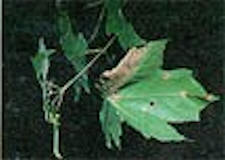 |

Tree woes
By John Fulton
[May 04, 2011] Tree leaf diseases -- With the cool, wet weather we have been experiencing, it is only a matter of time before the fungal diseases make themselves widely apparent. These would include apple scab on apples and crab apples, as well as anthracnose on the good-quality shade trees. Both diseases are present in their early state at this time.
|
To give a brief overview, these diseases are preventable but not
curable. They are seldom life-threatening to the tree or shrub,
but they can make things look rather unsightly. Many shade trees
losing a large percentage of their leaves will often set another
set of leaves within four to six weeks. Apples and crab apples
are less likely to set another set of leaves, but it sometimes
happens.
Anthracnose has different stages, depending on the time of infection. There is a bud stage of the disease, when buds are killed as they begin to open. Next is a leaf stage, which affects only leaves. This stage is the one we are commonly seeing, and it infects leaves and gradually consumes the leaf. And the other stage is the twig stage, which affects smaller twigs on trees and shrubs. This is one reason why sycamore trees tend to have so many small branches break. The infection leaves a brittle scar on the branch, which makes it susceptible to breakage. There is actually a specific anthracnose disease for each shade tree. This means sycamore anthracnose, maple anthracnose and so on. As I mentioned, once infection has occurred, it can't be cured. The main harm caused is the loss of food that would have been produced by the lost leaves and the loss of energy to set another set of leaves. The prevention part needs to begin with a regular spray program similar to production apples. This means starting when the leaves are just out of the bud in the early spring. The same kind of timing applies to ornamental trees. Fertilizer application at the lawn rate, to supply a pound of nitrogen per 1,000 square feet broadcast, will help the tree as much as anything. Spruce tree woes Many spruce trees, especially Colorado blue spruce, are not very well acclimated to our environment in central Illinois. The altered growing conditions often weaken the tree over a period of time, making it more susceptible to other diseases and insects.
Rhizosphaera needle cast is one of the main diseases of spruce. Symptoms include a purple cast to needles, needle drop and a tendency to start at the bottom of a tree and work upward. One key to control is removing infected needles and cleaning pruning equipment between cuts. Chemical control is possible by protecting new growth with chlorothalonil fungicides such as Bravo or Daconil 2787 or with manganese and zinc combinations such as Cleary's Protect T/O. These programs would probably have to be done for at least two years, and make sure to follow the recommendations on the product label.
Other diseases, such as diplodia tip blight and cytosphora canker, also affect spruce trees, and let's not forget spruce spider mites. Spruce spider mites have been active for a while and will probably continue to be active with the cool weather we have had this spring. This insect damage shows up as mottled needles, and there is usually fine webbing present. Needles may also drop from the spruce spider mite. Control of the mite can be accomplished with insecticidal soap or an appropriate miticide. [By JOHN FULTON, University of Illinois Extension]
|
 |






